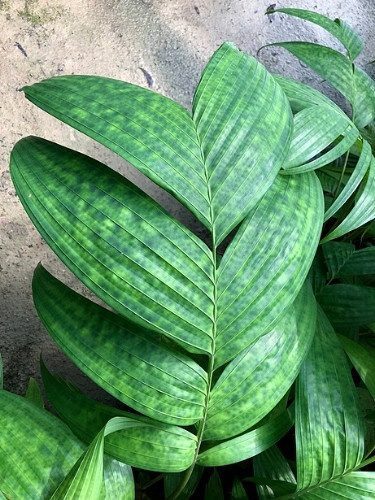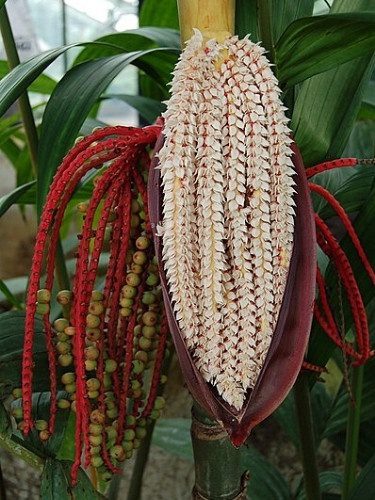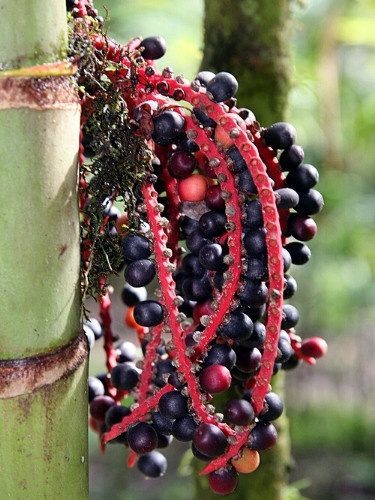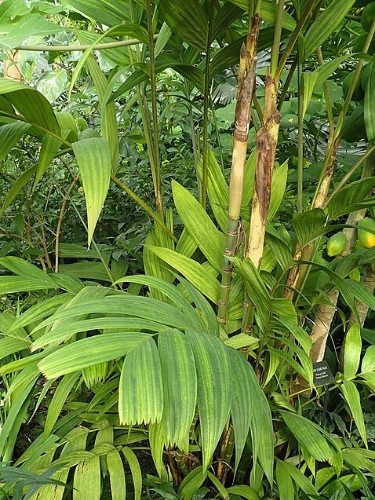
The Ivory Cane Palm (Pinanga coronata) is a monocious, clumping, perennial species that stands out with its large, dissected leaves and a beautiful cream-colored heart of palm. It has a slender green trunk that is erect and ringed, with a small greenish to ivory-colored palmette. It grows in dense clumps, similar to bamboo. Its leaves are large, slightly recurved, pinnate, with elongated and wide light green leaflets. They are evenly arranged and have a grooved surface. When they first emerge, they have a bronzed appearance, gradually turning green as they mature.
Inflorescences appear in the summer, below the heart of palm and among the leaves, initially protected by a large spathe. They are branched spikes that, upon blooming, have a yellow-cream color with small white flowers. The rachis gradually turns red over time.
After pollination, fruits develop between summer and fall. These are drupe-type, ellipsoid or obovate fruits that are initially red, turning black when ripe. There’s a common misconception that Pinanga coronata and P. kuhlli are distinct species. However, in the latest revision, P. kuhlli was considered a variety within P. coronata, namely P. coronata var ‘kuhlli’.

This palm species is suitable for planting in groups or as a standalone plant. It can enhance well-maintained lawns in parks and squares, as well as expansive residential gardens. It also looks great in corridors and near pool areas. However, it’s important to note that young plants do not tolerate direct sunlight for extended periods. Hence, using mature plants in exposed areas is recommended.
Young seedlings thrive in semi-shaded spots under larger trees. Placing very young plants in full sun can lead to scorched appearances and slow development. The Ivory Cane Palm can also be cultivated in pots during its early phase, bringing a touch of the tropical forest to indoor spaces like living rooms and offices. It’s also an excellent choice for winter gardens due to its compact size. It has a moderate growth rate and is easy to cultivate. Additionally, it’s quite hardy, requiring minimal maintenance such as the removal of dead or yellowing leaves.

It should be grown in partial shade, full sun, or filtered light, in fertile, slightly acidic soil rich in organic matter. Like most palms, young Pinanga plants do not tolerate full sun exposure. Furthermore, maintaining consistently moist soil is important. Watering should occur when the surface of the soil is dry to prevent water stress.
In summer, the frequency of watering should be increased due to higher plant water demand. However, over-watering can lead to issues, including diseases in the crown and roots, especially during colder periods. Therefore, reduce watering in winter.
It prefers warm to mild climates and high relative humidity. It can withstand light frosts and the low temperatures of subtropical winters, but it dislikes drought or frequent winds. Fertilization should be done during the growing season, mainly in spring and summer, using organic or slow-release fertilizers. Propagation is done through clump division or by seeds. For seed propagation, remove the ripe, freshly collected fruits and plant them immediately in sandy substrate, keeping it moist at temperatures between 20 to 25°C. Germination is not uniform and can occur between 30 to 80 days after planting.


